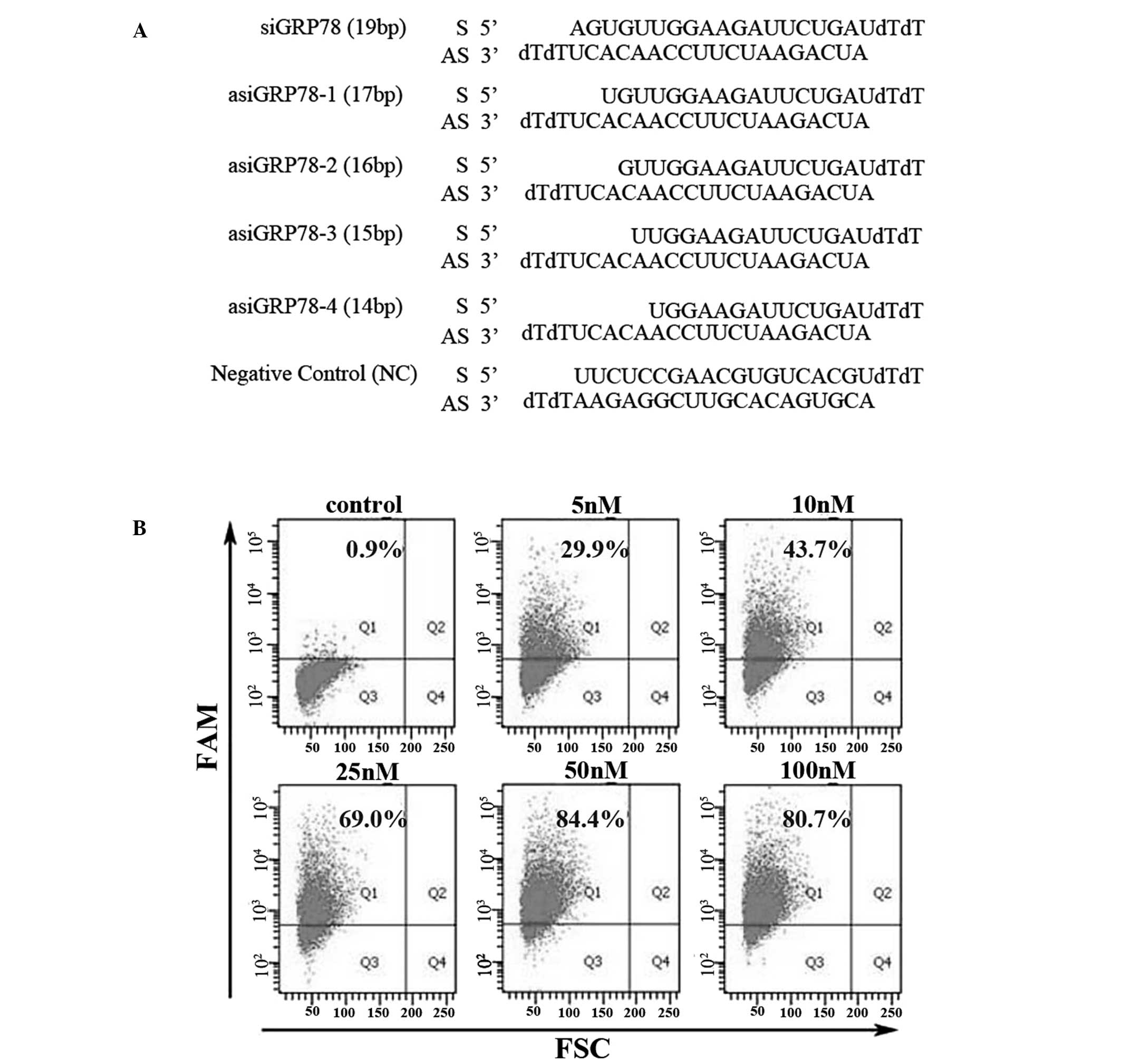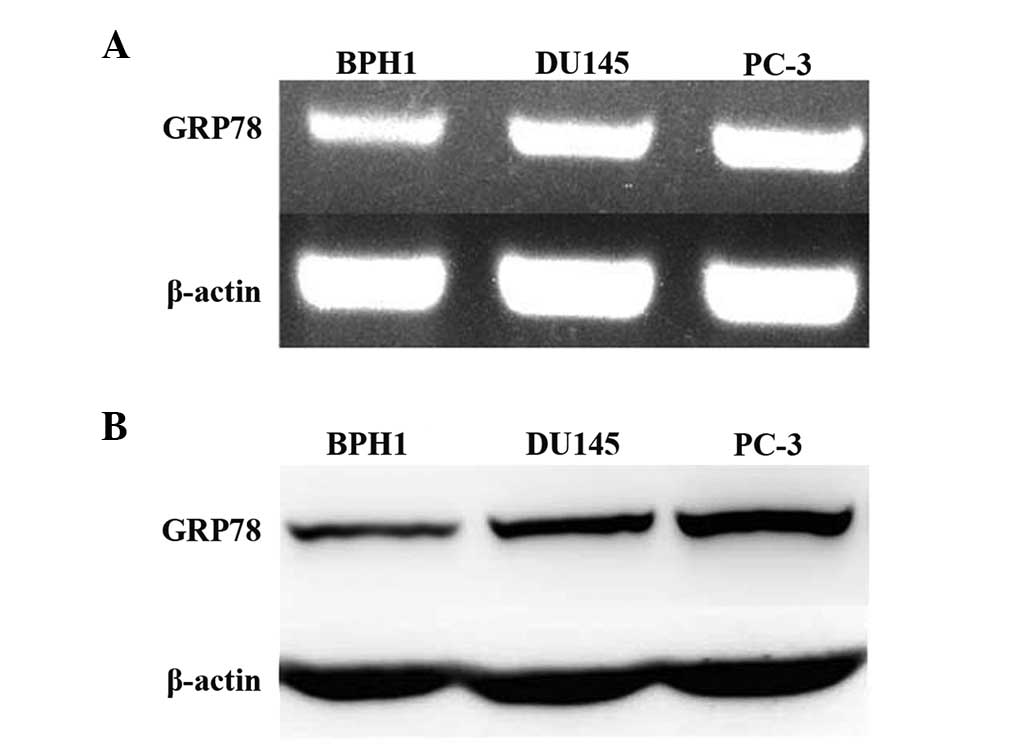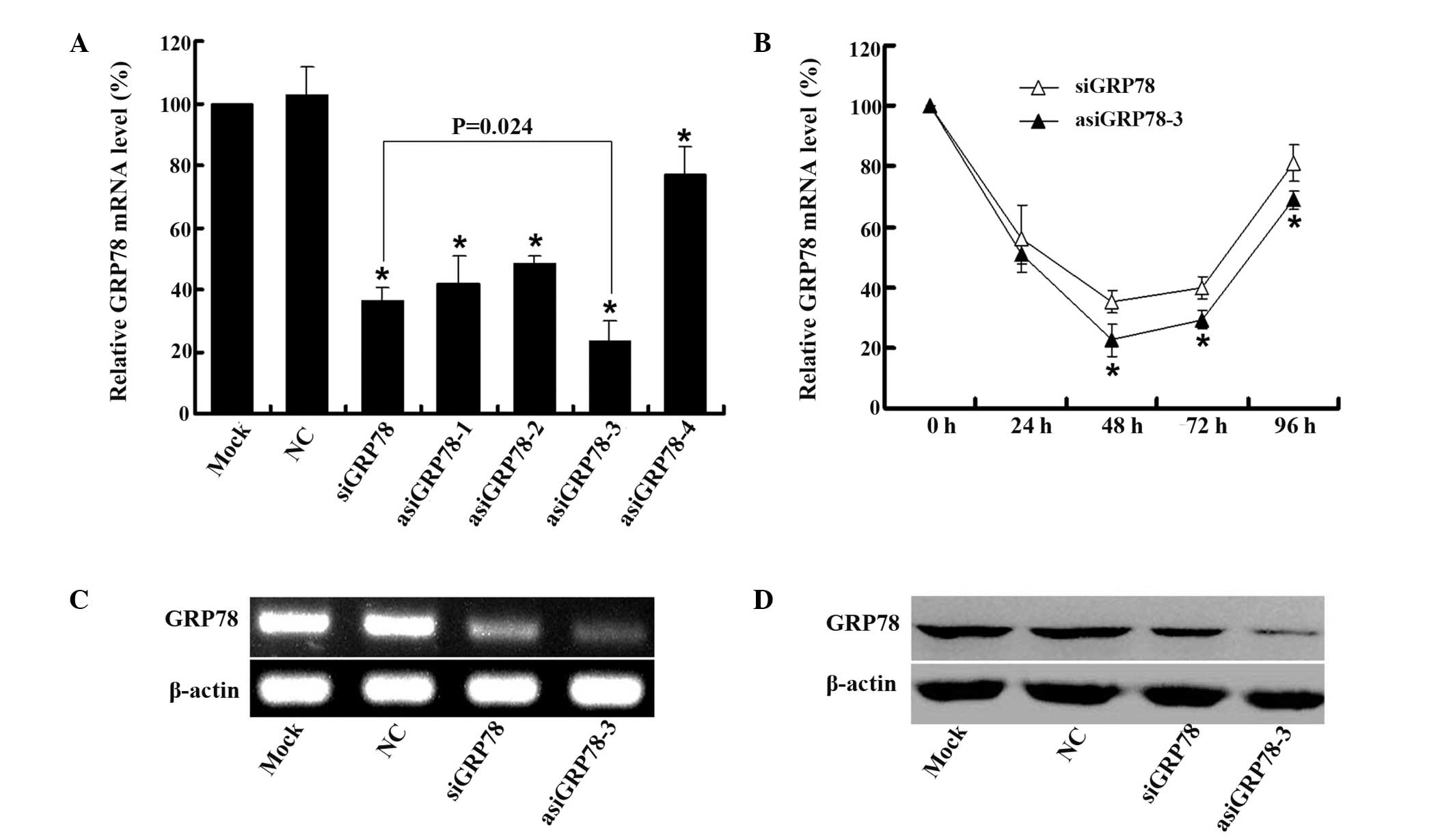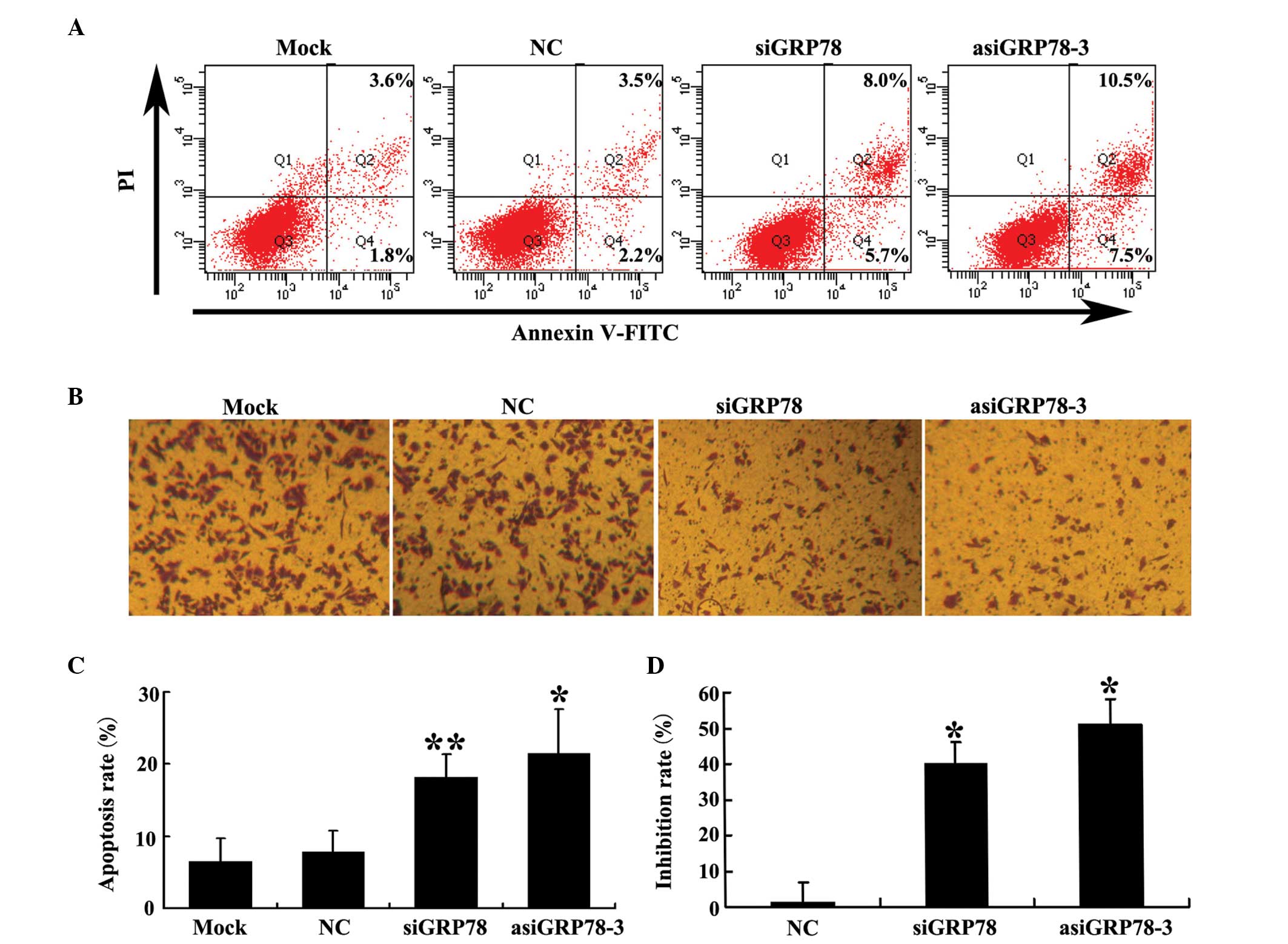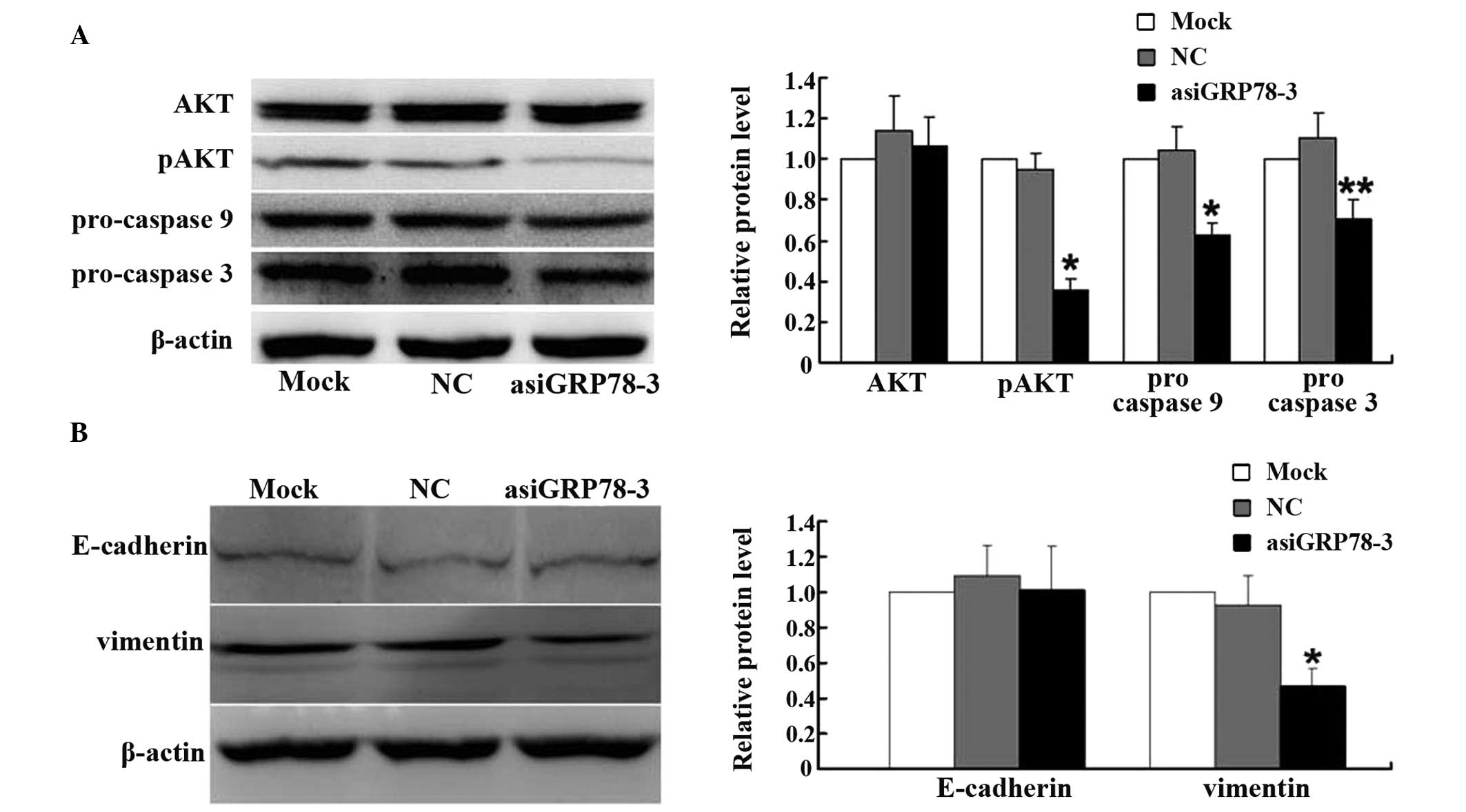Knockdown of glucose‑regulated protein 78/binding immunoglobulin heavy chain protein expression by asymmetric small interfering RNA induces apoptosis in prostate cancer cells and attenuates migratory capability
- Authors:
- Published online on: October 22, 2014 https://doi.org/10.3892/mmr.2014.2737
- Pages: 249-256
Abstract
Introduction
Prostate cancer (PCa) is one of the most common types of non-cutaneous malignant tumors in older males. According to the World Health Organization, ~899,000 new cases of PCa are diagnosed each year, and the worldwide mortality is ~258,000 per year (1). In China, the incidence of PCa and its associated mortality have significantly increased in recent years, largely as a result of longer lifespans and altered dietary habits. The androgen receptor is important in the initiation and progression of PCa. While tumors are often initially sensitive to androgen deprivation therapy (ADT), a significant proportion rapidly develop resistance and become androgen-independent (2,3). Thus, numerous studies have focused on identifying novel therapeutic targets in androgen-independent prostate cancer.
Glucose-regulated protein 78 (GRP78) is a heat shock protein, which is also termed binding immunoglobulin heavy chain protein (BiP). It is a multifunctional Ca2+-binding protein that participates in protein folding, transportation and degradation. It has also been shown to be involved in cancer cell survival (4,5). Previous studies in ovarian cancer, breast cancer and lung cancer have shown that high levels of GRP78 expression in tumors correlate with reduced cell differentiation and a poorer prognosis (6–8). Other studies have demonstrated that silencing GRP78 using RNA interference, induces apoptosis and inhibits migration in hepatoma cells (9,10). These findings suggest that GRP78/BiP may be a potential therapeutic target in malignant tumors. However, little is currently known regarding the importance of GRP78 in the development of PCa.
RNA interference (RNAi) is an effective method by which to silence genes of interest. As a result, it is an indispensable tool in experimental and clinical research. Certain small interfering RNAs (siRNAs) have demonstrated potential therapeutic value in multiple types of tumor, including colon, renal, liver and bladder cancers (11–14). Conventional RNAi methods rely on siRNAs consisting of 19–21 bp that form symmetrical duplexes. However, a number of unintended nonspecific effects triggered by siRNA structures have been demonstrated (15,16). Recent studies have indicated that gene silencing mediated by asymmetrical siRNAs (asiRNAs), which are siRNA duplexes with shortened sense strands, is more effective and shows greater specificity than when conventional symmetric siRNA is used (17–19).
In the present study, a series of GRP78-specific asiRNAs ranging from 14–17 bp in duplex region length were designed and their activity in the human androgen-independent prostate cancer cell line PC-3 was investigated. The aim was to evaluate the effect of these molecules on the expression of GRP78, and the ensuing effects of this on the apoptosis and migration of PC-3 cells.
Materials and methods
Cell culture
PC-3 and DU145 human prostate cancer cells (China Center for Type Culture Collection, Wuhan, China) were cultured in Dulbecco’s modified Eagle’s medium (DMEM; Gibco Life Technologies, Carlsbad, CA, USA). Non-malignant BPH1 human prostate cells (China Center for Type Culture Collection) were cultured in RPMI-1640 medium (Gibco Life Technologies) supplemented with 10% fetal bovine serum (FBS; Gibco Life Technologies), 100 mg/ml streptomycin and 100 U/ml penicillin (Goodbio Technology Co., Ltd., Wuhan, China). The cells were maintained in a cell incubator (Forma Scientific, Inc., Cincinnati, OH, USA) at 37°C under a humidified 5% CO2 atmosphere for 48 h.
Design and synthesis of siRNA and asiRNAs
The 19 nucleotide (nt) target sequence for GRP78 was selected from GenBank (accession no. NM_005347.4; nt sequence, 1293-1311). This sequence has previously been shown to downregulate GRP78 expression (10). The symmetrical siRNA (19bp duplex region), designed according to the target sequence, was designated as siGRP78. A series of asiRNAs with 5′ sense strands shortened by 2 nt to 5 nt were designed and designated asiGRP78-1, asiGRP78-2, asiGRP78-3 and asiGRP78-4 (Fig. 2A). These asiRNAs comprised a duplex region ranging from 14 to 17bp and their antisense sequence was identical to that of the siRNA. All siRNAs and asiRNAs were synthesized and purified by Invitrogen Life Technologies (Carlsbad, CA, USA). Two negative control siRNAs [with and without a carboxyfluorescein (FAM) label] were also synthesized by Invitrogen Life Technologies. The FAM-labeled siRNA was used to measure transfection efficiency, and the non-FAM-labeled siRNA was used for all other experiments.
Cell transfection and transfection efficiency assay
PC-3 cell transfection was performed using the INTERFERin® in vitro siRNA transfection reagent (Polyplus-Transfection SA, Brant, France) according to the manufacturer’s instructions for reverse transfection. Briefly, siRNA or asiRNA were diluted in 200 μl of Opti-MEM (Gibco Life Technologies, Carlsbad, CA, USA), and 12 μl of INTERFERin transfection reagent was mixed with the diluted siRNA/asiRNA. This mixture was incubated for 10 min at room temperature. It was then transferred into 6-well culture plates and mixed with 1.95 ml of antibiotic-free serum-free DMEM. PC-3 cells were immediately seeded onto the plates. The transfected cells were maintained in an incubator at 37°C. FBS (245 μl per well) was added into the medium at 10% final concentration, 8 h following transfection. To compare the efficiency of siRNA- and asiRNA-mediated silencing of GRP78, all transfections were maintained for 48 h.
To assess transfection efficiency, cells transfected with FAM-labeled siRNA were collected at 6 h post-transfection, rinsed three times with phosphate-buffered saline (PBS; Goodbio Technology Co., Ltd.) and resuspended in PBS. The cell suspensions were analyzed by flow cytometry (BD Biosciences, Franklin Lakes, NJ, USA).
Reverse transcription-polymerase chain reaction (RT-PCR) and quantitative PCR (qPCR)
Total RNA was isolated using an AxyPrep total RNA Miniprep Kit (Axygen Scientific, Inc., Union City, CA, USA) and was reverse transcribed into cDNA using the ReverTra Ace® First Strand cDNA Synthesis kit (Toyobo Co., Ltd., Osaka, Japan) according to the Manufacturer’s instructions. The first strand cDNA samples were amplified by RT-PCR using Taq PCR Mastermix (Tiangen Biotech Co., Ltd., Beijing, China) or by qPCR using Thunderbird™ SYBR® qPCR Mix (Toyobo Co., Ltd.). All primer sequences and the sizes of the PCR products are listed in Table I. For RT-PCR, the products were electrophoresed on 1.5% agarose gels (Goodbio Technology Co., Ltd.), stained with Goldview (Goodbio Technology Co., Ltd.), and visualized under ultraviolet light. β-Actin was used as a loading control. For qPCR, the relative GRP78 mRNA expression levels were calculated relative to β-actin according to the 2−ΔΔCt method.
Western blot analysis
Cells were harvested, rinsed and lysed with lysis buffer supplemented with phenylmethylsulfonylfluoride (Beyotime Institute of Biotechnology, Shanghai, China). Cell lysates were kept on ice for 30 min and centrifuged at 12,000 × g for 15 min to obtain lysate proteins. The protein concentration was measured using a bicinchoninic acid protein assay kit (Goodbio Technology Co., Ltd.,) and equal amounts of protein were resolved on 12% SDS-PAGE gels prior to transfer to a polyvinylidene difluoride membrane. Samples were blocked in 5% skimmed milk and the membranes were incubated with primary antibody overnight at 4°C. The following primary antibodies were used: Anti-GRP78/Bip rabbit polyclonal antibody (1:1,000; catalog number, 11587-1-AP), anti-E-cadherin rabbit polyclonal antibody (1:1,000, catalog number, 20874-1-AP) and anti-caspase 3 rabbit polyclonal antibody (1:1,000; catalog number, 19677-1-AP) (ProteinTech Group, Inc., Chicago, IL, USA); anti-vimentin rabbit polyclonal antibody (1:500; catalog number, S0859; Epitomics, Burlingame, CA, USA); anti-AKT rabbit monoclonal antibody (1:1,000; catalog number, 4691s) and anti-pAKT (ser473) rabbit monoclonal antibody (1:200; catalog number, 4058s) (Cell Signaling Technology, Inc., Danvers, MA, USA); and anti-caspase 9 rabbit polyclonal antibody (1:500; catalog number, sc-8355) and anti-β-actin rabbit polyclonal antibody (1:1,500; catalog number, sc-130656) (Santa Cruz Biotechnology, Inc., Dallas, TX. USA). Following incubation with primary antibodies, the membranes were probed with horseradish peroxidase-conjugated goat anti-rabbit polyclonal secondary antibodies (1:5,000; catalog number, sc-2004; Santa Cruz Biotechnology, Inc.) at room temperature for 2 h, and the reactive bands were detected using the BeyoECL plus (Beyotime Institute of Biotechnology) reagent. Relative protein expression levels were calculated based on the relative optical densities of the protein bands with Quantity One 4.62 software (Bio-Rad Laboratories, Hercules, CA, USA).
Apoptosis assay
Transfected cells were harvested at 48 h post-transfection, rinsed twice with PBS and resuspended in 500 μl binding buffer. The cell suspensions were immediately incubated for 15 min with 5 μl propidium iodide (PI) and 5 μl fluorescein isothiocyanate (FITC)-labeled Annexin V (KeyGen, Nanjing, China) at room temperature. Samples were analyzed on a flow cytometer (BD Biosciences) within 1 h of the end of incubation.
Cell migration assay
Cell migration assays were performed using 6.5-mm Transwell® chambers with 8.0-μm-pore polycarbonate membranes (Corning Life Sciences, Tewksbury, MA, USA) in 24-well culture plates. To perform serum starvation, complete medium in a six-well plate was removed and replaced with serum-free DMEM 24 h following transfection. The serum-starved cells were harvested 12 h later and resuspended in DMEM with 0.1% bovine serum albumin (Goodbio Technology Co., Ltd.). Equal numbers of cells were seeded in the upper chamber. DMEM with 10% FBS was added to the lower chamber. Following 12 h of incubation, the cells in the upper chamber were removed and the cells on the lower surface of the Transwell® membrane were stained with crystal violet (Goodbio Technology Co., Ltd.) and photographed by an Olympus BX51 microscope (Olympus Corporation, Tokyo, Japan). To evaluate the inhibitory rate of migration, crystal violet-stained cells from each group were dissolved in 100 μl 10% ethylic acid. The optical density (OD) of the solution was measured at 570 nm using a microplate reader (Tecan Group Ltd., Männedorf, Switzerland). The inhibitory rate was determined using the following equation: Inhibition rate (%) = [1-(OD of treatment group/OD of mock group)] × 100. The mock group was transfected in the absence of RNA.
Statistical analysis
All statistical analyses were performed using SPSS statistical 19.0 software (IBM SPSS, Armonk, NY, USA). One-way analysis of was used to compare the results of three or more groups, and Student’s t-test was used to compare differences between two groups. Data are expressed as the mean ± standard deviation. P<0.05 were considered to indicate a statistically significant difference.
Results
Grp78 expression is elevated in prostate cancer cell lines
It has previously been reported that the expression of GRP78 is upregulated in human prostate cancer tissues (20). In the current study the expression of GRP78 in three prostate cell lines, including two cancerous (PC-3 and DU145) cell lines and one non-malignant (BPH1) cell line was measured. RT-PCR results showed that GRP78 mRNA expression was higher in PC-3 and DU145 cells than it was in BPH1 cells. The expression of GRP78 was highest in PC-3 cells (Fig. 1A). Western blot analysis showed that GRP78 protein expression correlated with the mRNA expression profile in all three cell lines (Fig. 1B). PC-3 cells were selected as a model of androgen-independent prostate cancer and used for subsequent experiments.
Optimization of transfection efficiency
To optimize siRNA and asiRNA transfection efficiency, PC-3 cells were transfected with FAM-labeled siRNA at final concentrations of 0, 5, 10, 25, 50 and 100 nM for 6 h. The transfection efficiency for each condition was assessed by flow cytometry. At an siRNA concentration of 50 nM, the transfection efficiency was 84.4%. Flow cytometry analysis also revealed there was no improvement in transfection efficiency with siRNA concentrations >50 nM (Fig. 2B). Therefore, a final siRNA (asiRNA) concentration of 50 nM for all of the siRNA or asiRNA transfection groups was used in all subsequent experiments.
Silencing GRP78 gene expression by siRNA and asiRNA
We compared the efficiency of siRNA- and asiRNA-mediated silencing of GRP78. As shown in Fig. 3A, qPCR data demonstrated that GRP78 expression was reduced in the siRNA- and asiRNA-transfected groups. The relative levels of GRP78 mRNA were decreased by ~77% in the 15bp asiRNA group and by ~63% in the siRNA group. GRP78 expression was decreased by ~23, 52 and 58% in cells transfected with a 14, a 16 and a 17 bp asiRNA, respectively. The gene-silencing efficiency of the 15bp asiRNA (asiGRP78-3) was the highest among all the groups and was significantly higher than that of the siRNA (siGRP78) groups (P=0.024).
The duration of gene silencing following siRNA/asiRNA transfection was also investigated. PC-3 cells were transfected with 50 nM asiGRP78-3 or siGRP78. Cells were harvested at 0, 24, 48, 72 and 96 h following transfection. The relative GRP78 mRNA levels were determined by qPCR. As shown in Fig. 3B, GRP78 expression in the asiGRP78-3 group was significantly lower than that in the siGRP78 group at 48, 72 and 96 h (P<0.05). Thus, the duration of gene silencing was greater in the asiGRP78-3 group.
Transfection of asiGRP78-3 into PC-3 cells resulted in reduced expression of GRP78 at the mRNA and protein levels (Figs. 3C and D). For this reason, asiGRP78-3 (15 bp asiRNA) was selected for use in subsequent experiments examining the potential antitumor effects of GRP78 downregulation.
Silencing of GRP78 by asiRNA induces PC-3 cell apoptosis and inhibits PC-3 cell migration
The percentage of apoptotic transfected cells was detected by flow cytometry using double staining for Annexin V-FITC and PI 48 h following transfection. As shown in Fig. 4A and C, the percentage of apoptotic cells was significantly higher in the GRP78-depleted groups than it was in either the negative control (NC) group or the mock group. Additionally, the percentage of cells in which apoptosis was induced by asiGRP78-3 was higher than that induced by siGRP78.
The effect of GRP78 knockdown on PC-3 cell migration using was investigated using Transwell® chambers. Migration inhibition in each of the four groups were calculated as described in the materials and methods section. As shown in Fig. 4B and D, knockdown of GRP78 decreased the migratory capability of PC-3 cells compared with the control group. This effect was greater in the asiGRP78-3 group than it was in the siGRP78 group (P=0.044).
Apoptosis-related and migration-related proteins are regulated by asiRNA
To further investigate how GRP78 may regulate apoptosis, the expression of pro-caspase 9, pro-caspase 3, and phosphorylated AKT (pAKT) in the GRP78-depleted groups and the control groups were measured. At 48 h post-transfection, western blot analysis showed reduced expression of all three of these markers of apoptosis following GRP78 depletion (Fig. 5A).
To investigate the possible mechanisms by which GRP78 may regulate cellular migration, the expression of E-cadherin and vimentin by were measured western blotting. As shown in Fig. 5B, vimentin expression was significantly decreased in the asiGRP78-3 group compared with the control group; however, the expression of E-cadherin was unchanged.
Discussion
Primary treatment options for patients with prostate cancer include surgery and ADT. In some cases, for example in elderly patients, surgery may not be possible. In these cases, ADT is the only available option. However, patients receiving ADT often develop resistance to treatment after a period of time. Thus, the identification of alternative therapies for prostate cancer is critical.
Over the last decade, RNA interference has been proven to be effective in the treatment of cancer. The majority of conventional RNA interference methods use 19–25 bp symmetrical oligonucleotides. However, Sun et al (19) first demonstrated the successful silencing of a gene using asiRNA. They showed that asiRNA is superior to symmetrical siRNA for the purpose of gene silencing. A number of other studies have since confirmed this (18,21–23). In addition to more efficient gene silencing, asiRNA typically causes fewer unpredictable off-target effects and produces a longer duration of knockdown compared with conventional symmetric siRNA (18,19,21–23). Thus, downregulation of gene expression using asiRNA has become common practice. In the present study, silencing of GRP78 by asiRNA and siRNA was compared. All of the asiRNAs that were tested led to decreased levels of GRP78 at the mRNA level. asiGRP78-3 (15bp) was particularly effective at downregulating the expression of GRP78 and was significantly more effective than the symmetric siRNA in this regard. Furthermore, transfection of the asiRNA into PC-3 cells had a more marked effect on apoptosis and migration compared with the conventional siRNA. Previous studies have shown that asiRNA duplex regions range from 15–19 bp. The most appropriate length is likely to depend on the specific sequence of the target gene of interest and the design of the interfering RNA sequence. Therefore, for different target genes, a series of asiRNAs with different duplex region lengths should be designed and screened for the one that exhibits the greatest knockdown effect (22).
GRP78 is hypothesized to promote tumor cell survival through two mechanisms. It is important in the unfolded protein response (UPR). Changes in the microenvironment (such as glucose depletion or hypoxia) or the administration of anticancer drugs may induce endoplasmic reticulum stress (ERS) leading to the aggregation of misfolded proteins. ERS then activates the UPR in an attempt to correct these misfolded proteins in order to relieve the cellular stress. GRP78 is an endoplasmic reticulum chaperone that assists in the proper folding of proteins. Cancer cells tend to produce large amounts of variant proteins, which require high levels of GRP78 for proper folding (24). In addition, when it is bound to α2-macroglobulin, T-cadherin or Cripto, GRP78 activates either the phosphoinositide 3-kinase/AKT pathway or the mitogen-activated protein kinase pathway, which promote tumor cell proliferation (24–26). In previous studies, GRP78 has been linked to various stages of tumor development (6–8). GRP78 expression was also shown to be significantly higher in prostate cancer tissues compared with that in the normal prostate. Notably, this elevated GRP78 expression was correlated with significantly decreased progression-free and overall survival (20). In the current study it was shown that GRP78 mRNA and protein levels are higher in the prostate cancer cell lines PC-3 and DU145 than in the prostate hyperplasia cell line BPH1 Thus, these findings are consistent with previous reports.
Several groups have examined the effect of GRP78 inhibition on cancer cell biology. Blocking GRP78 using monoclonal antibodies inhibits cell proliferation and induces apoptosis in several types of tumor cells (4,27,28). Others have reported that downregulating GRP78 expression using RNAi induces apoptosis in lung, liver, cervical and colorectal cancer cells (8,10,29,30). Similarly, the present study showed that downregulation of GRP78 in PC-3 cells using asiRNA significantly increases apoptosis. These results indicate that GRP78 is important in the survival of prostate cancer cells. To further investigate the mechanisms underlying GRP78-mediated apoptosis, the expression levels of pAKT, pro-caspase 9, and pro-caspase 3 were examined. Following GRP78 depletion, the levels of pAKT were reduced, which is consistent with recent reports (31–33). AKT phosphorylation inhibits caspase 9 activation by phosphorylating pro-caspase 9 (34). Thus, downregulation of pAKT activates pro-caspase 9 and pro-caspase 3 leading to an increase in apoptosis (35). In the present study, decreased levels of pro-caspase 9 and pro-caspase 3 were also detected following GRP78 knockdown. Thus, inhibition of AKT phosphorylation and the activation of caspase 9 and caspase 3 may be a possible mechanism by which GRP78 downregulation induces apoptosis in PC-3 cells.
Tumor metastasis is a complex, multi-step process that involves, at least in part, the ability of cancer cells to migrate. The current study found that downregulation of GRP78 with asiRNA significantly decreased the migratory capacity of PC-3 cells (by ~50%). Excluding the effects on apoptosis of GRP78 silencing in these cells at the same time point (apoptosis rate ~20%), it is likely that GRP78 downregulation also inhibits PC-3 cell migration. Such findings are consistent with previous studies performed in liver, lung, and head and neck cancers (8,9,36). Finally, in the present study E-cadherin and vimentin protein levels were examined, and it was shown that vimentin levels were decreased following GRP78 knockdown. By contrast, E-cadherin levels did not change. Vimentin is important role in cancer cell motility (37). Thus, it is hypothesized that the decreased migration of PC-3 cells following GRP78 silencing may be related to vimentin downregulation, although the underlying mechanism requires further investigation.
In conclusion, the current study showed that GRP78-specific asiRNA effectively downregulates GRP78 expression in PC-3 cells. It provides evidence that GRP78 downregulation increases PC-3 cell apoptosis and decreases cell migratory ability. The use of GRP78-specific asiRNA may therefore be a novel therapeutic approach for prostate cancer.
Acknowledgements
This study was supported by the National Natural Science Foundation of China (nos. 81101944 and 81173608), the Natural Science Foundation of Hubei (no. 2011CDB202) and the Seed Foundation of HUST (no. 2011JC038).
Abbreviations:
|
ADT |
androgen deprivation therapy |
|
asiRNA |
asymmetric small interfering RNA |
|
GRP78 |
glucose-regulated protein 78 |
|
NC |
negative control |
|
PCa |
prostate cancer |
|
PI |
propidium iodide |
|
RNAi |
RNA interference |
References
|
Semenas J, Allegrucci C, Boorjian SA, Mongan NP and Persson JL: Overcoming drug resistance and treating advanced prostate cancer. Curr Drug Targets. 13:1308–1323. 2012. View Article : Google Scholar : PubMed/NCBI | |
|
Feldman BJ and Feldman D: The development of androgen-independent prostate cancer. Nat Rev Cancer. 1:34–45. 2001. View Article : Google Scholar : PubMed/NCBI | |
|
Oh WK and Kantoff PW: Management of hormone refractory prostate cancer: current standards and future prospects. J Urol. 160:1220–1229. 1998. View Article : Google Scholar : PubMed/NCBI | |
|
Misra UK, Mowery Y, Kaczowka S and Pizzo SV: Ligation of cancer cell surface GRP78 with antibodies directed against its COOH-terminal domain up-regulates p53 activity and promotes apoptosis. Mol Cancer Ther. 8:1350–1362. 2009. View Article : Google Scholar : PubMed/NCBI | |
|
Misra UK, Wang F and Pizzo SV: Transcription factor TFII-I causes transcriptional upregulation of GRP78 synthesis in prostate cancer cells. J Cell Biochem. 106:381–389. 2009. View Article : Google Scholar : PubMed/NCBI | |
|
Huang LW, Lin CY, Lee CC, Liu TZ and Jeng CJ: Overexpression of GRP78 is associated with malignant transformation in epithelial ovarian tumors. Appl Immunohistochem Mol Morphol. 20:381–385. 2012. View Article : Google Scholar : PubMed/NCBI | |
|
Lee E, Nichols P, Spicer D, Groshen S, Yu MC and Lee AS: GRP78 as a novel predictor of responsiveness to chemotherapy in breast cancer. Cancer Res. 66:7849–7853. 2006. View Article : Google Scholar : PubMed/NCBI | |
|
Sun Q, Hua J, Wang Q, et al: Expressions of GRP78 and Bax associate with differentiation, metastasis, and apoptosis in non-small cell lung cancer. Mol Biol Rep. 39:6753–6761. 2012. View Article : Google Scholar : PubMed/NCBI | |
|
Li H, Song H, Luo J, Liang J, Zhao S and Su R: Knockdown of glucose-regulated protein 78 decreases the invasion, metalloproteinase expression and ECM degradation in hepatocellular carcinoma cells. J Exp Clin Cancer Res. 31:392012. View Article : Google Scholar | |
|
Wang Q, Shu R, He H, et al: Co-silencing of Birc5 (survivin) and Hspa5 (Grp78) induces apoptosis in hepatoma cells more efficiently than single gene interference. Int J Oncol. 41:652–660. 2012.PubMed/NCBI | |
|
Prados J, Melguizo C, Roldan H, et al: RNA Interference in the treatment of colon cancer. BioDrugs. 27:317–327. 2013. View Article : Google Scholar : PubMed/NCBI | |
|
Shi H, Deng JH, Wang Z, Cao KY, Zhou L and Wan H: Knockdown of clusterin inhibits the growth and migration of renal carcinoma cells and leads to differential gene expression. Mol Med Rep. 8:35–40. 2013.PubMed/NCBI | |
|
Zhao Y, Jian W, Gao W, et al: RNAi silencing of c-Myc inhibits cell migration, invasion, and proliferation in HepG2 human hepatocellular carcinoma cell line: c-Myc silencing in hepatocellular carcinoma cell. Cancer Cell Int. 13:232013. View Article : Google Scholar : PubMed/NCBI | |
|
Zhu Z, Zhu Z, Pang Z, Xing Y, Wan F, Lan D and Wang H: Short hairpin RNA targeting FOXQ1 inhibits invasion and metastasis via the reversal of epithelial-mesenchymal transition in bladder cancer. Int J Oncol. 42:1271–1278. 2013.PubMed/NCBI | |
|
Clark PR, Pober JS and Kluger MS: Knockdown of TNFR1 by the sense strand of an ICAM-1 siRNA: dissection of an off-target effect. Nucleic Acids Res. 36:1081–1097. 2008. View Article : Google Scholar : PubMed/NCBI | |
|
Jackson AL and Linsley PS: Noise amidst the silence: off-target effects of siRNAs? Trends Genet. 20:521–524. 2004. View Article : Google Scholar : PubMed/NCBI | |
|
Chang CI, Yoo JW, Hong SW, et al: Asymmetric shorter-duplex siRNA structures trigger efficient gene silencing with reduced nonspecific effects. Mol Ther. 17:725–732. 2009. View Article : Google Scholar : PubMed/NCBI | |
|
Jo SG, Hong SW, Yoo JW, Lee CH, Kim S and Lee DK: Selection and optimization of asymmetric siRNA targeting the human c-MET gene. Mol Cells. 32:543–548. 2011. View Article : Google Scholar : PubMed/NCBI | |
|
Sun X, Rogoff HA and Li CJ: Asymmetric RNA duplexes mediate RNA interference in mammalian cells. Nat Biotechnol. 26:1379–1382. 2008. View Article : Google Scholar : PubMed/NCBI | |
|
Daneshmand S, Quek ML, Lin E, et al: Glucose-regulated protein GRP78 is up-regulated in prostate cancer and correlates with recurrence and survival. Hum Pathol. 38:1547–1552. 2007. View Article : Google Scholar : PubMed/NCBI | |
|
Lv L, Xiao XY, Gu ZH, Zeng FQ, Huang LQ and Jiang GS: Silencing USP22 by asymmetric structure of interfering RNA inhibits proliferation and induces cell cycle arrest in bladder cancer cells. Mol Cell Biochem. 346:11–21. 2011. View Article : Google Scholar : PubMed/NCBI | |
|
Yin Y, Chen X, Zhang CD, et al: Asymmetric siRNA targeting the bcl-2 gene inhibits the proliferation of cancer cells in vitro and in vivo. Int J Oncol. 42:253–260. 2013.PubMed/NCBI | |
|
Yuan Z, Wu X, Liu C, Xu G and Wu Z: Asymmetric siRNA: new strategy to improve specificity and reduce off-target gene expression. Hum Gene Ther. 23:521–532. 2012. View Article : Google Scholar : PubMed/NCBI | |
|
Zhang LH and Zhang X: Roles of GRP78 in physiology and cancer. J Cell Biochem. 110:1299–1305. 2010. View Article : Google Scholar : PubMed/NCBI | |
|
Philippova M, Ivanov D, Joshi MB, et al: Identification of proteins associating with glycosylphosphatidylinositol-anchored T-cadherin on the surface of vascular endothelial cells: role for Grp78/BiP in T-cadherin-dependent cell survival. Mol Cell Biol. 28:4004–4017. 2008. View Article : Google Scholar | |
|
Shani G, Fischer WH, Justice NJ, Kelber JA, Vale W and Gray PC: GRP78 and Cripto form a complex at the cell surface and collaborate to inhibit transforming growth factor beta signaling and enhance cell growth. Mol Cell Biol. 28:666–677. 2008. View Article : Google Scholar : PubMed/NCBI | |
|
Cohen M and Petignat P: Purified autoantibodies against glucose-regulated protein 78 (GRP78) promote apoptosis and decrease invasiveness of ovarian cancer cells. Cancer Lett. 309:104–109. 2011. View Article : Google Scholar | |
|
Rasche L, Duell J, Morgner C, et al: The natural human IgM antibody PAT-SM6 induces apoptosis in primary human multiple myeloma cells by targeting heat shock protein GRP78. PLoS One. 8:e634142013. View Article : Google Scholar : PubMed/NCBI | |
|
Suzuki T, Lu J, Zahed M, Kita K and Suzuki N: Reduction of GRP78 expression with siRNA activates unfolded protein response leading to apoptosis in HeLa cells. Arch Biochem Biophys. 468:1–14. 2007. View Article : Google Scholar : PubMed/NCBI | |
|
Xing X, Li Y, Liu H, Wang L and Sun L: Glucose regulated protein 78 (GRP78) is overexpressed in colorectal carcinoma and regulates colorectal carcinoma cell growth and apoptosis. Acta Histochem. 113:777–782. 2011. View Article : Google Scholar : PubMed/NCBI | |
|
Chang YJ, Huang YP, Li ZL and Chen CH: GRP78 knockdown enhances apoptosis via the down-regulation of oxidative stress and Akt pathway after epirubicin treatment in colon cancer DLD-1 cells. PLoS One. 7:e351232012. View Article : Google Scholar : PubMed/NCBI | |
|
Fu Y, Wey S, Wang M, et al: Pten null prostate tumorigenesis and AKT activation are blocked by targeted knockout of ER chaperone GRP78/BiP in prostate epithelium. Proc Natl Acad Sci USA. 105:19444–19449. 2008. View Article : Google Scholar : PubMed/NCBI | |
|
Zhang LH, Yang XL, Zhang X, Cheng JX and Zhang W: Association of elevated GRP78 expression with increased astrocytoma malignancy via Akt and ERK pathways. Brain Res. 1371:23–31. 2011. View Article : Google Scholar : PubMed/NCBI | |
|
Cardone MH, Roy N, Stennicke HR, et al: Regulation of cell death protease caspase-9 by phosphorylation. Science. 282:1318–1321. 1998. View Article : Google Scholar : PubMed/NCBI | |
|
Li P, Nijhawan D, Budihardjo I, et al: Cytochrome c and dATP-dependent formation of Apaf-1/caspase-9 complex initiates an apoptotic protease cascade. Cell. 91:479–489. 1997. View Article : Google Scholar : PubMed/NCBI | |
|
Chiu CC, Lin CY, Lee LY, et al: Glucose-regulated protein 78 regulates multiple malignant phenotypes in head and neck cancer and may serve as a molecular target of therapeutic intervention. Mol Cancer Ther. 7:2788–2797. 2008. View Article : Google Scholar : PubMed/NCBI | |
|
McInroy L and Määttä A: Down-regulation of vimentin expression inhibits carcinoma cell migration and adhesion. Biochem Biophys Res Commun. 360:109–114. 2007. View Article : Google Scholar : PubMed/NCBI |



